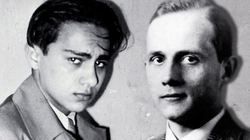Herschel Grynszpan and Kristallnacht
Kristallnacht
On the 7 November 1938, a seventeen-year-old German student by the name Herschel Grynszpan purchased a handgun in Paris after saying goodbye in a postcard to his parents who the Nazis were trying to forcibly expel from Germany to Poland because of their Jewish and Polish backgrounds. His parents were stranded with other Jews within the Polish border town of zbąszynek. Due to their dire situation, they sent their son a postcard begging him to find a way to help them.
Angered at the way his family were being treated and finding himself unable to come to their aid, he decided to seek revenge on those who had done this to his family. With revenge on his mind, Herschel visited the German Embassy at 78 Rue de Lille, Paris and asked to see an Embassy official. He was taken to the office of Ernst vom Rath, a junior official within the Embassy. Once in the office pulled out the revolver and fired a few rounds into the body of the official. Vom Rath was rushed to hospital and Herschel gave himself up to the French police.
On the 9 November 1938, Ernst Vom Rath succumbed to his wounds and died, but before he died, Hitler had officially elevated his status to 'Ambassador' and awarded him a state funeral which Hitler would attend. The murder of Vom Rath was used by Joseph Goebbels, Hitler's minister for Propaganda and Enlightenment as a catalyst for another pogrom against the Jews of Germany in what would become known as Kristallnacht (Night of Broken Glass).
The instigators of the pogrom (Goebbels and Reinhardt Heydrich) hid in the shadows to make it seem that it was a spontaneous outpouring of grief and anger from the population as a whole, to achieve this, the Brownshirts (the Sturmabteilung) were forbidden to wear their uniforms whilst rampaging through the cities and towns looking for Jews to attack and synagogues to burn.
Thousands of Jews were seized and sent to concentration camps and hundreds murdered. Jewish businesses and synagogues were ransacked and torched. The streets were covered in broken glass that twinkled in the moonlight.
There was widespread criticism of the pogrom throughout the world, and even Hermann Goering, who was head of the Four-Year Plan was shocked at the amount of damage caused, as this had a direct effect on the economy and he was worried that insurance companies would be hit the hardest. To elevate the dangers to the economy, the Jews were officially blamed for all the destruction and violence caused that night and therefore forfeited any insurance claims (the state inherited the insurance money) and as a group they were forced to pay an ‘atonement fine’ of one billion Reichsmarks.
When war broke out in September 1939, Herschel Grynszpan, who was being held in Fresnes Prison just south of Paris was moved in 1940 to the prison in Toulouse in the south of France because the Germans had broken through French defences and was now advancing rapidly towards Paris.
After France's capitulation, the country was divided into two zones, the occupied zone in the North, and the unoccupied South, where the new French government, under Marshal Philippe Pétain was located at Vichy.
On the 18 July 1940, the Vichy government handed Grynszpan over to the Germans who then transferred him back to Paris, from there he was taken to Gestapo headquarters at Prinz-Albrecht-Straße, Berlin for interrogation. He was then held at a local prison (Moabit) before entering the concentration camps at Flossenbürg and then Sachsenhausen. Whilst he was being held, Adolf Eichmann, according to his own testimony at his trial in Jerusalem, claimed to have met and spoke with him either in 1943 or 1944.
Germany's Minister of Propaganda, Joseph Goebbels, had wanted to put Grynszpan through a public show trial but seemed to have ditched the idea after Hershel had claimed that he had had a homosexual relationship with the junior German diplomat.
There is no record of what happened to Grynszpan after he entered the camps, but we do know that the Nazis murdered certain high-profile prisoners just before the end of the war to ensure they didn't outlive the regime.
Both Hershel Grynszpan’s parents survived the war and applied to a German court in 1960 to have their son declared dead.
On 1 June 1960, the Lower Court of Amtsgericht in Hanover officially declared Herschel Grynszpan dead, and fixed the 8 May 1945 (the end of the war in Europe) as the date of his death.
It has been claimed that Herschel Grynszpan had survived his incarceration and a story appeared showing a photograph of a young man supposedly being him.
It is highly dubious that the image in the photo is Grynszpan but there is slight resemblance however, knowing what we know about high profile prisoners in the Nazi regime, very few rarely escaped execution, and Adolf Eichmann himself a prisoner in Jerusalem said that he had heard nothing about him surviving.
